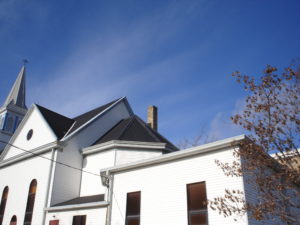
Brodeur Bros. was unoccupied the entire year – absolutely no sign of an entry or exit.
A nesting attempt was made at the other 4 sites and 3 attempts were successful (75% success). This ties the previous record of 3 successful breeding attempts in 2013, however, in that year all 5 nest sites had a breeding pair onsite (60% success).
The SE Club Amical nest failure took place on July 10 (Day 6-8). Crop dusting took place outside St A. on July 2, 3, and 9.
The number of fledglings per site was low, although behavioural estimates tend to be underestimates: 1 fledgling at NE Club Amical (behavioural obs.); 2 fledglings at the Church (behavioural obs.); and 3 fledglings at the Main St site (clutch size = 3 = 100% fledging based on physical evidence; behavioural observations estimated n=2 fledglings).
A pdf version of the 2017 Nest Outcome Summary for St. Adolphe may be seen at http://www.mbchimneyswift.com/Documents/stadolphe_2017.pdf
Tim and I are connected to a U of W grad student, Martine Balcaen, who had mosquitoe traps at Howden C.C. on Red River Dr and Marchand Rd (my area northwest of St A.) She noted interesting pulses of mosquitoes between trap locations and shifts in the mass of mosquitoes relative to other species of flying insects. We will follow up with her to see if some explanation can be offered for the successful year of Chimney Swift breeding in St A. relative to the stinking low numbers of mosquitoes in the valley all season long!
The big question to ponder this year is “If mosquitoes never present as a primary food source at the beginning of the season, therefore they do not decline in numbers with mosquito abatement programs mid-season, do Chimney Swifts shift to other prey species with better breeding success?” There’s another big difference this year though: when the hot temp’s arrived the strong winds didn’t; compare to 2011 when rip roaring winds blew for days on end with 30+ C temps – in 2011 the Church nest failed Aug. 2nd on Day 25 (3-5 days before fledging was due) when no bugs could be found.
There’s always a good reason to keep checking in on the birds next year…
Barb Stewart
